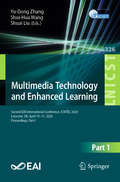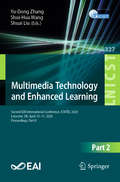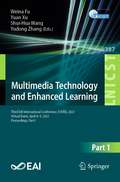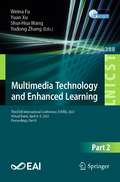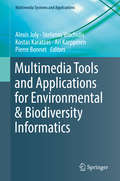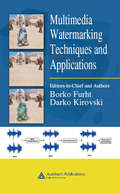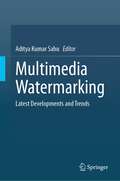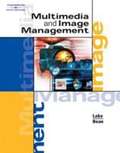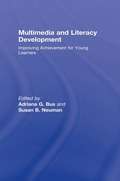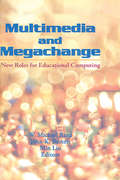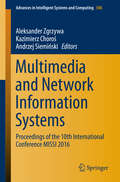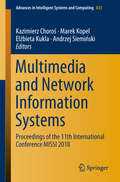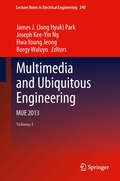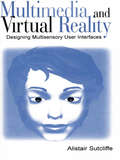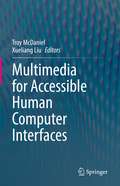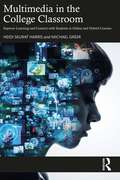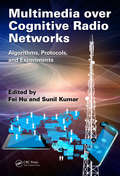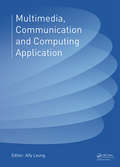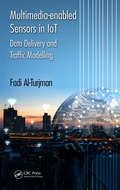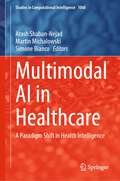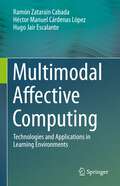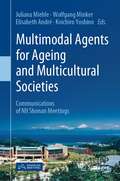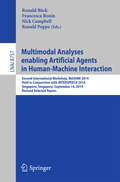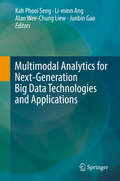- Table View
- List View
Multimedia Technology and Enhanced Learning: Second EAI International Conference, ICMTEL 2020, Leicester, UK, April 10-11, 2020, Proceedings, Part I (Lecture Notes of the Institute for Computer Sciences, Social Informatics and Telecommunications Engineering #326)
by Shuai Liu Shui-Hua Wang Yu-Dong ZhangThis two-volume book constitutes the refereed proceedings of the Second International Conference on Multimedia Technology and Enhanced Learning, ICMTEL 2020, held in Leicester, United Kingdom, in April 2020. Due to the COVID-19 pandemic all papers were presented in YouTubeLive. The 83 revised full papers have been selected from 158 submissions. They describe new learning technologies which range from smart school, smart class and smart learning at home and which have been developed from new technologies such as machine learning, multimedia and Internet of Things.
Multimedia Technology and Enhanced Learning: Second EAI International Conference, ICMTEL 2020, Leicester, UK, April 10-11, 2020, Proceedings, Part II (Lecture Notes of the Institute for Computer Sciences, Social Informatics and Telecommunications Engineering #327)
by Shuai Liu Shui-Hua Wang Yu-Dong ZhangThis two-volume book constitutes the refereed proceedings of the Second International Conference on Multimedia Technology and Enhanced Learning, ICMTEL 2020, held in Leicester, United Kingdom, in April 2020. Due to the COVID-19 pandemic all papers were presented in YouTubeLive. The 83 revised full papers have been selected from 158 submissions. They describe new learning technologies which range from smart school, smart class and smart learning at home and which have been developed from new technologies such as machine learning, multimedia and Internet of Things.
Multimedia Technology and Enhanced Learning: Third EAI International Conference, ICMTEL 2021, Virtual Event, April 8–9, 2021, Proceedings, Part I (Lecture Notes of the Institute for Computer Sciences, Social Informatics and Telecommunications Engineering #387)
by Yuan Xu Shui-Hua Wang Weina Fu Yudong ZhangThis two-volume book constitutes the refereed proceedings of the 3rd International Conference on Multimedia Technology and Enhanced Learning, ICMTEL 2021, held in April 2021. Due to the COVID-19 pandemic the conference was held virtually. The 97 revised full papers have been selected from 208 submissions. They describe new learning technologies which range from smart school, smart class and smart learning at home and which have been developed from new technologies such as machine learning, multimedia and Internet of Things.
Multimedia Technology and Enhanced Learning: Third EAI International Conference, ICMTEL 2021, Virtual Event, April 8–9, 2021, Proceedings, Part II (Lecture Notes of the Institute for Computer Sciences, Social Informatics and Telecommunications Engineering #388)
by Yuan Xu Shui-Hua Wang Weina Fu Yudong ZhangThis two-volume book constitutes the refereed proceedings of the 3rd International Conference on Multimedia Technology and Enhanced Learning, ICMTEL 2021, held in April 2021. Due to the COVID-19 pandemic the conference was held virtually. The 97 revised full papers have been selected from 208 submissions. They describe new learning technologies which range from smart school, smart class and smart learning at home and which have been developed from new technologies such as machine learning, multimedia and Internet of Things.
Multimedia Tools and Applications for Environmental & Biodiversity Informatics (Multimedia Systems and Applications)
by Pierre Bonnet Stefanos Vrochidis Alexis Joly Kostas Karatzas Ari KarppinenThis edited volume focuses on the latest and most impactful advancements of multimedia data globally available for environmental and earth biodiversity. The data reflects the status, behavior, change as well as human interests and concerns which are increasingly crucial for understanding environmental issues and phenomena. This volume addresses the need for the development of advanced methods, techniques and tools for collecting, managing, analyzing, understanding and modeling environmental & biodiversity data, including the automated or collaborative species identification, the species distribution modeling and their environment, such as the air quality or the bio-acoustic monitoring. Researchers and practitioners in multimedia and environmental topics will find the chapters essential to their continued studies.
Multimedia Watermarking Techniques and Applications (Internet And Communications Ser.)
by Darko KirovskiIntellectual property owners must continually exploit new ways of reproducing, distributing, and marketing their products. However, the threat of piracy looms as a major problem with digital distribution and storage technologies. Multimedia Watermarking Techniques and Applications covers all current and future trends in the design of modern
Multimedia Watermarking: Latest Developments and Trends
by Aditya Kumar SahuMultimedia watermarking is a key ingredient for integrity verification, transaction tracking, copyright protection, authentication, copy control, and forgery detection. This book provides an extensive survey from the fundamentals to cutting-edge digital watermarking techniques. One of the crucial aspects of multimedia security is the ability to detect forged/tampered regions from the multimedia object. In this book, we emphasized how tampering detection, localization, and recovery of manipulated information not only limits but also eliminates the scope of unauthorized usage. Finally, this book provides the groundwork for understanding the role of intelligent machines and blockchain in achieving better security in multimedia watermarking. Readers will find it easy to comprehend the wide variety of applications, theoretical principles, and effective solutions for protecting intellectual rights soon after reading this book.
Multimedia and Image Management
by Karen Bean Susan LakeMultimedia and Image Management prepares students for a business world in which they will be expected to use business-standard software applications and to complete projects and solve problems. The applications include word processing, presentation, digital photography, image manipulation, animation, and speech recognition. This text teaches students the more creative end of business technology.
Multimedia and Image Management: Activities
by Karen Bean Susan E. L. LakeMost of the applications discussed within this book are available for both the Windows and Macintosh operating systems, and the activities described can be worked easily on either system.
Multimedia and Literacy Development: Improving Achievement for Young Learners
by Susan B. Neuman Adriana G. BusRepresenting the state of the art in multimedia applications and their promise for enhancing early literacy development, this volume broadens the field of reading research by looking beyond print-only experiences to young readers’ encounters with multimedia stories on the Internet and DVD. Multimedia storybooks include, in addition to static pictures and written text, features such as oral text, animations, sounds, zooms, and scaffolds designed to help convey meaning. These features are changing how young children read text, and also provide technology-based scaffolds for helping struggling readers. Multimedia and Literacy Development reports experimental research and practices with multimedia stories indicating that new dimensions of media contribute to young children’s ability to understand stories and to read texts independently. This is the first synthesis of evidence-based research in this field. Four key themes are highlighted: Understanding the multimedia environment for learning Designing multimedia applications for learning New approaches to storybook reading Multimedia applications in classroom instruction. Written in jargon-free language for an international audience of students in university courses on literacy and information technology, researchers, policymakers, program developers, and media specialists, this volume is essential reading for all professionals interested in early literacy and early interventions.
Multimedia and Megachange: New Roles for Educational Computing
by W Michael Reed John K BurtonThe use of multimedia strikes at the very heart of traditional teaching and learning methods, and is changing the way educators think about the whole process of teaching and learning. Multimedia and Megachange spurs ideas for the use of interactive technology to revolutionize teaching and learning. It describes and analyzes issues and trends that are currently setting a research and development agenda for educators.Contributors to this volume explore all fronts on which computer technology are changing the educational process:concept and theoryresearchapplicationdesignMultimedia and Megachange opens up the exciting world of how technology is dramatically changing how teachers teach and students learn. It also highlights spin-off changes for classroom management, greater sources of information, and improved evaluation and grading techniques.
Multimedia and Network Information Systems
by Aleksander Zgrzywa Kazimierz Choroś Andrzej SiemińskiDiscusses a broad scope of subject matters including multimedia systems in their widest sense, web systems and network technologies. This monograph also includes texts which deals with traditional information systems that draw on the experience of the multimedia and network systems.
Multimedia and Network Information Systems: Proceedings of the 11th International Conference MISSI 2018 (Advances in Intelligent Systems and Computing #833)
by Kazimierz Choroś Andrzej Siemiński Marek Kopel Elżbieta KuklaThese proceedings collect papers presented at the 11th International Conference on Multimedia & Network Information Systems (MISSI 2018), held from 12 to 14 September 2018 in Wrocław, Poland. The keynote lectures, given by four outstanding scientists, are also included here. The Conference attracted a great number of scientists from across Europe and beyond, and hosted the 6th International Workshop on Computational Intelligence for Multimedia Understanding as well as four special sessions. The majority of the papers describe various artificial intelligence (AI) methods applied to multimedia and natural language (NL) processing; they address hot topics such as virtual and augmented reality, identity recognition, video summarization, intelligent audio processing, accessing multilingual information and opinions, video games, and innovations in Web technologies. Accordingly, the proceedings provide a cutting-edge update on work being pursued in the rapidly evolving field of Multimedia and Internet Information Systems.
Multimedia and Ubiquitous Engineering
by James J. Park Hwa Young Jeong Borgy Waluyo Joseph Kee-Yin NgThe new multimedia standards (for example, MPEG-21) facilitate the seamless integration of multiple modalities into interoperable multimedia frameworks, transforming the way people work and interact with multimedia data. These key technologies and multimedia solutions interact and collaborate with each other in increasingly effective ways, contributing to the multimedia revolution and having a significant impact across a wide spectrum of consumer, business, healthcare, education, and governmental domains. Multimedia and Ubiquitous Engineering provides an opportunity for academic and industry professionals to discuss recent progress in the area of multimedia and ubiquitous environment including models and systems, new directions, novel applications associated with the utilization and acceptance of ubiquitous computing devices and systems.
Multimedia and Virtual Reality: Designing Multisensory User Interfaces
by Alistair SutcliffeThis book is primarily a summary of research done over 10 years in multimedia and virtual reality, which fits within a wider interest of exploiting psychological theory to improve the process of designing interactive systems. The subject matter lies firmly within the field of HCI, with some cross-referencing to software engineering. Extending Sutcliffe's views on the design process to more complex interfaces that have evolved in recent years, this book: *introduces the background to multisensory user interfaces and surveys the design issues and previous HCI research in these areas; *explains the basic psychology for design of multisensory user interfaces, including the Interactive Cognitive Subsystems cognitive model; *describes elaborations of Norman's models of action for multimedia and VR, relates these models to the ICS cognitive model, and explains how the models can be applied to predict the design features necessary for successful interaction; *provides a design process from requirements, user and domain analysis, to design of representation in media or virtual worlds and facilities for user interaction therein; *covers usability evaluation for multisensory interfaces by extending existing well-known HCI approaches of heuristic evaluation and observational usability testing; and *presents two special application areas for multisensory interfaces: educational applications and virtual prototyping for design refinement. To download images and figures free of charge that enhance and clarify materials discussed in chapters 1-7 go to http://www.co.umist.ac.uk/centreULhci/MMVRbook.htm
Multimedia for Accessible Human Computer Interfaces
by Xueliang Liu Troy McDanielThe book Multimedia for Accessible Human Computer Interfaces is to be the first resource to provide in-depth coverage on topical areas of multimedia computing (images, video, audio, speech, haptics, VR/AR, etc.) for accessible and inclusive human computer interfaces. Topics are grouped into thematic areas spanning the human senses: Vision, Hearing, Touch, as well as Multimodal applications. Each chapter is written by different multimedia researchers to provide complementary and multidisciplinary perspectives. Unlike other related books, which focus on guidelines for designing accessible interfaces, or are dated in their coverage of cutting edge multimedia technologies, Multimedia for Accessible Human Computer Interfaces takes an application-oriented approach to present a tour of how the field of multimedia is advancing access to human computer interfaces for individuals with disabilities.Under Theme 1 “Vision-based Technologies for Accessible Human Computer Interfaces”, multimedia technologies to enhance access to interfaces through vision will be presented including: “A Framework for Gaze-contingent Interfaces”, “Sign Language Recognition”, “Fusion-based Image Enhancement and its Applications in Mobile Devices”, and “Open-domain Textual Question Answering Systems”. Under Theme 2 “Auditory Technologies for Accessible Human Computer Interfaces”, multimedia technologies to enhance access to interfaces through hearing will be presented including: “Speech Recognition for Individuals with Voice Disorders” and “Socially Assistive Robots for Storytelling and Other Activities to Support Aging in Place”. Under Theme 3 “Haptic Technologies for Accessible Human Computer Interfaces”, multimedia technologies to enhance access to interfaces through haptics will be presented including: “Accessible Smart Coaching Technologies Inspired by Elderly Requisites” and “Haptic Mediators for Remote Interpersonal Communication”. Under Theme 4 “Multimodal Technologies for Accessible Human Computer Interfaces”, multimedia technologies to enhance access to interfaces through multiple modalities will be presented including: “Human-Machine Interfaces for Socially Connected Devices: From Smart Households to Smart Cities” and “Enhancing Situational Awareness and Kinesthetic Assistance for Clinicians via Augmented-Reality and Haptic Shared-Control Technologies”.
Multimedia in the College Classroom: Improve Learning and Connect with Students in Online and Hybrid Courses
by Heidi Skurat Harris Michael GreerThis practical guide to multimedia in online college instruction provides easy-to-follow instructions for designing multimedia assignments that maximize student learning while reducing cognitive load.This book presents the learning process as a complex, multidimensional experience that includes texts as well as auditory and visual elements. Each chapter includes research-based activities to develop instructors’ multimedia skills. The book leverages cutting edge cognitive research to improve accessibility and design, while also providing practical asynchronous and synchronous activities that engage learners.Multimedia in the College Classroom is the ideal resource for any higher education instructor, administrator, or leader who wishes to learn about, reflect on, and implement research-based learning strategies through the targeted use of multimedia.
Multimedia over Cognitive Radio Networks: Algorithms, Protocols, and Experiments
by Sunil Kumar Fei HuWith nearly 7 billion mobile phone subscriptions worldwide, mobility and computing have become pervasive in our society and business. Moreover, new mobile multimedia communication services are challenging telecommunication operators. To support the significant increase in multimedia traffic-especially video-over wireless networks, new technological
Multimedia, Communication and Computing Application: Proceedings of the 2014 International Conference on Multimedia, Communication and Computing Application (MCCA 2014), Xiamen, China, October 16-17, 2014
by Ally Leung2014 International Conference on Multimedia, Communication and Computing Application (MCCA2014), Xiamen, China, Oct 16-17, 2014, provided a forum for experts and scholars of excellence from all over the world to present their latest work in the area of multimedia, communication and computing applications. In recent years, the multimedia techno
Multimedia-enabled Sensors in IoT: Data Delivery and Traffic Modelling
by Fadi Al-TurjmanThis book gives an overview of best effort data and real-time multipath routing protocols in WMSN. It provides results of recent research in design issues affecting the development of strategic multipath routing protocols that support multimedia data traffic in WMSN from an IoT perspective, plus detailed analysis on the appropriate traffic models.
Multimodal AI in Healthcare: A Paradigm Shift in Health Intelligence (Studies in Computational Intelligence #1060)
by Simone Bianco Arash Shaban-Nejad Martin MichalowskiThis book aims to highlight the latest achievements in the use of AI and multimodal artificial intelligence in biomedicine and healthcare. Multimodal AI is a relatively new concept in AI, in which different types of data (e.g. text, image, video, audio, and numerical data) are collected, integrated, and processed through a series of intelligence processing algorithms to improve performance. The edited volume contains selected papers presented at the 2022 Health Intelligence workshop and the associated Data Hackathon/Challenge, co-located with the Thirty-Sixth Association for the Advancement of Artificial Intelligence (AAAI) conference, and presents an overview of the issues, challenges, and potentials in the field, along with new research results. This book provides information for researchers, students, industry professionals, clinicians, and public health agencies interested in the applications of AI and Multimodal AI in public health and medicine.
Multimodal Affective Computing: Technologies and Applications in Learning Environments
by Hugo Jair Escalante Ramón Zatarain Cabada Héctor Manuel LópezThis book explores AI methodologies for the implementation of affective states in intelligent learning environments. Divided into four parts, Multimodal Affective Computing: Technologies and Applications in Learning Environments begins with an overview of Affective Computing and Intelligent Learning Environments, from their fundamentals and essential theoretical support up to their fusion and some successful practical applications. The basic concepts of Affective Computing, Machine Learning, and Pattern Recognition in Affective Computing, and Affective Learning Environments are presented in a comprehensive and easy-to-read manner. In the second part, a review on the emerging field of Sentiment Analysis for Learning Environments is introduced, including a systematic descriptive tour through topics such as building resources for sentiment detection, methods for data representation, designing and testing the classification models, and model integration into a learning system. The methodologies corresponding to Multimodal Recognition of Learning-Oriented Emotions are presented in the third part of the book, where topics such as building resources for emotion detection, methods for data representation, multimodal recognition systems, and multimodal emotion recognition in learning environments are presented. The fourth and last part of the book is devoted to a wide application field of the combination of methodologies, such as Automatic Personality Recognition, dealing with issues such as building resources for personality recognition, methods for data representation, personality recognition models, and multimodal personality recognition for affective computing. This book can be very useful not only for beginners who are interested in affective computing and intelligent learning environments, but also for advanced and experts in the practice and developments of the field. It complies an end-to-end treatment on these subjects, especially with educational applications, making it easy for researchers and students to get on track with fundamentals, established methodologies, conventional evaluation protocols, and the latest progress on these subjects.
Multimodal Agents for Ageing and Multicultural Societies: Communications of NII Shonan Meetings
by Wolfgang Minker Elisabeth André Juliana Miehle Koichiro YoshinoThis book aims to explore and discuss theories and technologies for the development of socially competent and culture-aware embodied conversational agents for elderly care. To tackle the challenges in ageing societies, this book was written by experts who have a background in assistive technologies for elderly care, culture-aware computing, multimodal dialogue, social robotics and synthetic agents. Chapter 1 presents a vision of an intelligent agent to illustrate the current challenges for the design and development of adaptive systems. Chapter 2 examines how notions of trust and empathy may be applied to human–robot interaction and how it can be used to create the next generation of emphatic agents, which address some of the pressing issues in multicultural ageing societies. Chapter 3 discusses multimodal machine learning as an approach to enable more effective and robust modelling technologies and to develop socially competent and culture-aware embodied conversational agents for elderly care. Chapter 4 explores the challenges associated with real-world field tests and deployments. Chapter 5 gives a short introduction to socio-cognitive language processing that describes the idea of coping with everyday language, irony, sarcasm, humor, paralinguistic information such as the physical and mental state and traits of the dialogue partner, and social aspects. This book grew out of the Shonan Meeting seminar entitled “Multimodal Agents for Ageing and Multicultural Societies” held in 2018 in Japan. Researchers and practitioners will be helped to understand the emerging field and the identification of promising approaches from a variety of disciplines such as human–computer interaction, artificial intelligence, modelling, and learning.
Multimodal Analyses enabling Artificial Agents in Human-Machine Interaction
by Ronald Böck Francesca Bonin Nick Campbell Ronald PoppeThis book constitutes the thoroughly refereed post-workshop proceedings of the Second Workshop on Multimodal Analyses Enabling Artificial Agents in Human Interaction, MA3HMI 2014, held in Conjunction with INTERSPEECH 2014, in Singapore, Singapore, on September 14th, 2014. The 9 revised papers presented together with a keynote talk were carefully reviewed and selected from numerous submissions. They are organized in two sections: human-machine interaction and dialogs and speech recognition.
Multimodal Analytics for Next-Generation Big Data Technologies and Applications
by Li-Minn Ang Kah Phooi Seng Alan Wee-Chung Liew Junbin GaoThis edited book will serve as a source of reference for technologies and applications for multimodality data analytics in big data environments. After an introduction, the editors organize the book into four main parts on sentiment, affect and emotion analytics for big multimodal data; unsupervised learning strategies for big multimodal data; supervised learning strategies for big multimodal data; and multimodal big data processing and applications. The book will be of value to researchers, professionals and students in engineering and computer science, particularly those engaged with image and speech processing, multimodal information processing, data science, and artificial intelligence.
